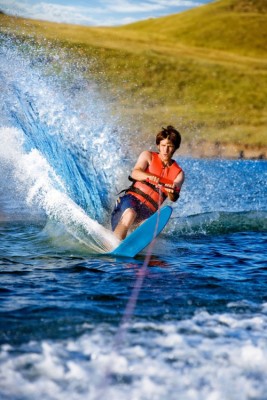 With summer in full swing, people are heading out to the lakes in record numbers. We’ve already covered some of the more common foot-related injuries at the beach, but today, we take a look at some foot injuries that occur on the water – more specifically when you’re being pulled behind the boat on water skis. Here are three common foot and ankle injuries that occur while water skiing.
With summer in full swing, people are heading out to the lakes in record numbers. We’ve already covered some of the more common foot-related injuries at the beach, but today, we take a look at some foot injuries that occur on the water – more specifically when you’re being pulled behind the boat on water skis. Here are three common foot and ankle injuries that occur while water skiing.
Water Ski Injury
1. Ankle Sprains – As you probably guessed, a sprained ankle is the most common foot-related injury that water skiers report. In fact, it’s the most common injury to any part of the body while water skiing. If a skier “catches an edge,” the force of the water can pull his or her feet backwards in a hurry. When this happens, the leg can turn outwards or inwards. An outward ankle sprain is called an ankle inversion, and when it rolls inward, it’s known as an eversion sprain. The eversion sprain is the more serious type of sprain, as it affects the stable ligaments on the inside of your ankle.
2. Fractures – Skiers who fall at high speeds or at an awkward angle can suffer an even more serious injury – a fracture. Skiers can suffer a variety of different fractures, but the most common are an ankle fracture or a fracture of the talus. Both types of fractures are accompanied by considerable pain, swelling and bruising. Surgery is generally required for talus fractures, but other ankle fractures can heal with just a cast and some rest.
3. Achilles Tendon Injuries – Achilles was struck down by an injury to the back of his foot, and it’s also a spot where many water skiers suffer injuries. The biggest tendon in the body can rupture if it gets stretched beyond normal range of motion, or if the skier hits the water with extreme force. This can happen if a skier lands awkwardly while going over the wake or while landing a jump, but it’s also been known to occur when a skier tries to kick off a ski to transition to one-footed skiing. Just like talus fractures, Achilles injuries typically need surgery to properly heal, and it takes anywhere from 9 to 15 months before a person can return to full physical activity.
Water Ski Injury Prevention Tips
Here are some tips to consider to help prevent ankle injuries while water skiing:
- Strength and conditioning exercises.
- Adjust the skis so they are snug enough that your feet aren’t wobbling while turning, but ensure they are loose enough to come off in the event of a crash.
- If you think you’re injured, don’t push it.
- Make sure you and your boat’s captain are on the same page when it comes to speed and turns.
If you do get injured while water skiing this summer, be sure to seek an evaluation from a foot specialist!